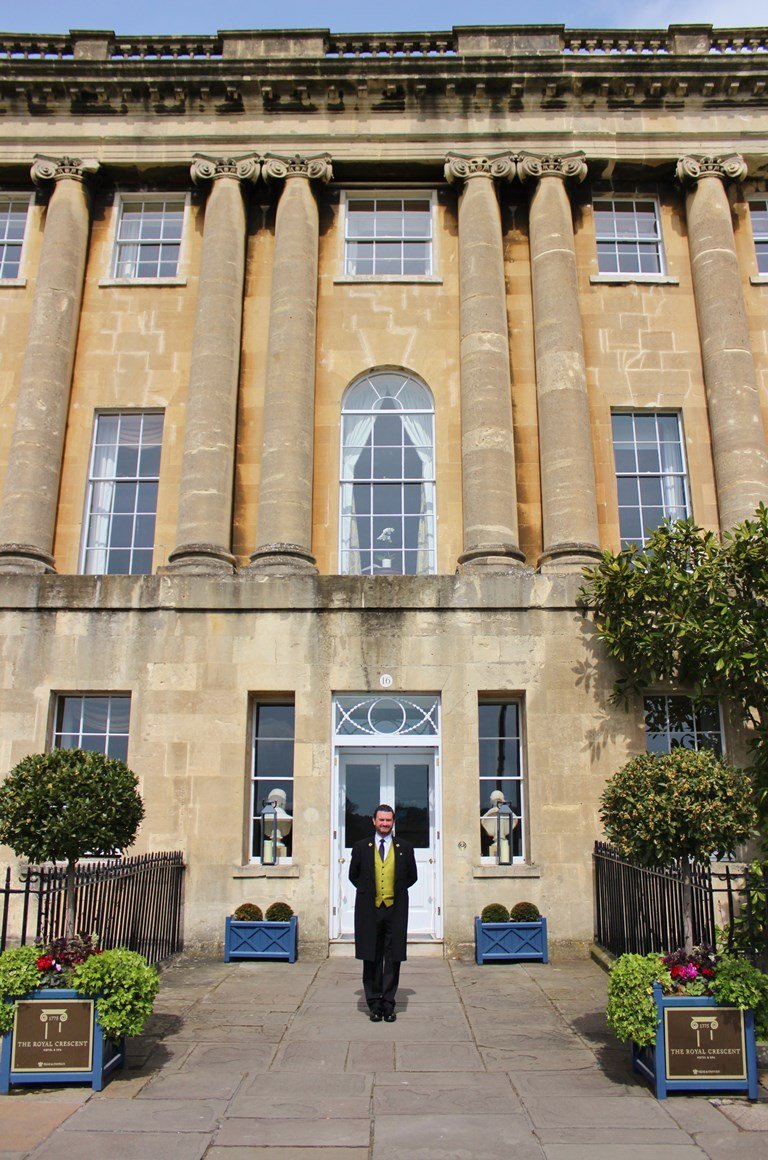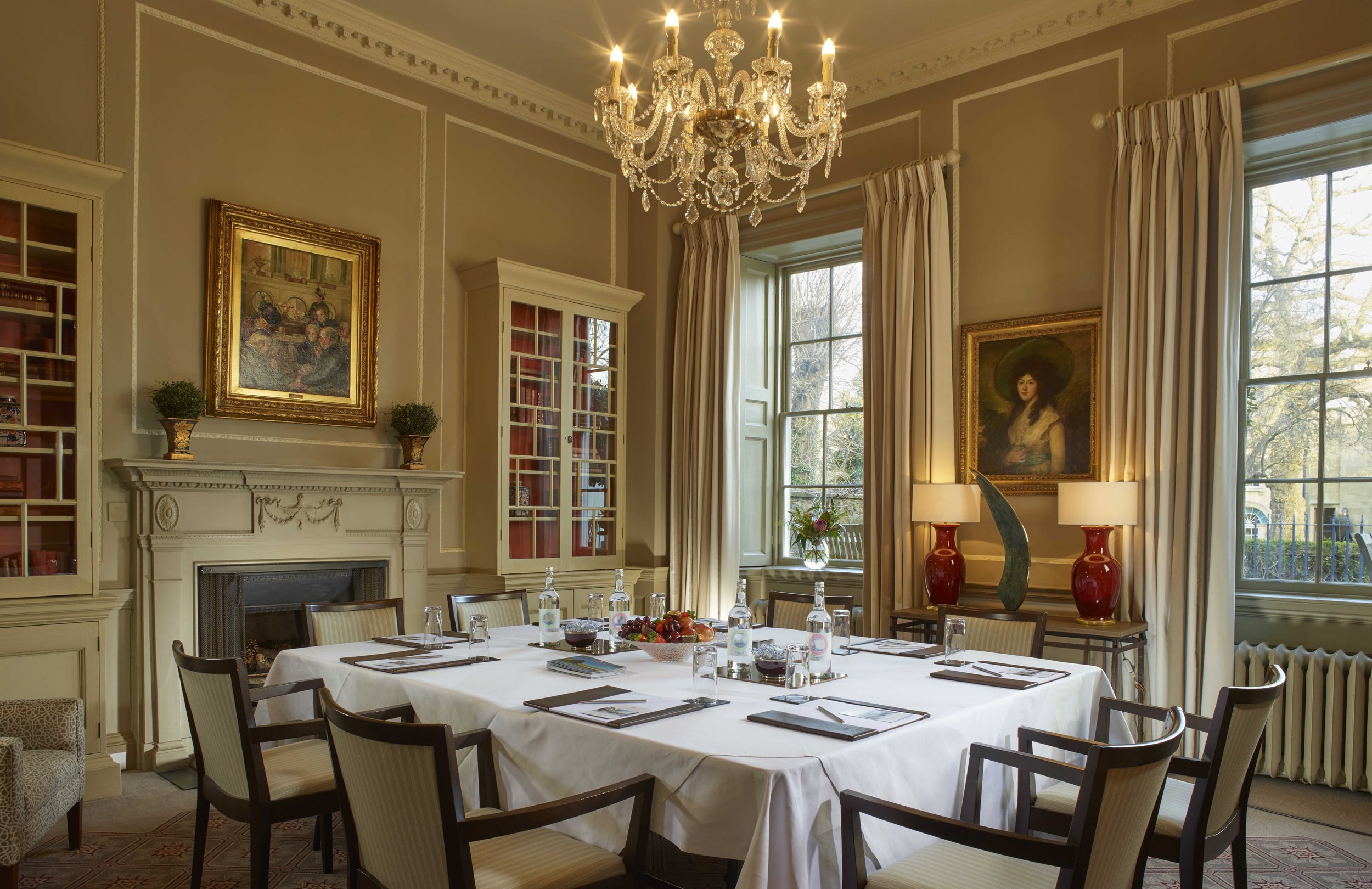Series 1 : HISTORIC HOTEL – THE ROYAL CRESCENT
The Royal Crescent Hotel, Bath - Images Courtesy of the Royal Crescent
On 12th May 1767, a foundation stone was laid among fields fringing the north western edge of Bath. Never before had a crescent-shaped terrace of attached houses been proposed. The architect, John Wood, intended that the new development would complement the nearby Circus which his father - John Wood Sr, commonly the Elder - had begun in 1754. The son’s vision of British Georgian architecture, was one of a majestic classical façade arranged in a sweeping curve and to absolute exterior uniformity; John Wood the Younger would contract individual developers to build to the exact specifications - down to such particulars as white woodwork - that he demanded. However, his visions was entirely focused on the façade; the builders would be free to create interiors and rears in any way that they or their clients saw fit. This approach prompted one of our favourite and apt observations : ‘Queen Anne in front, Sally Anne behind,’ as the contemporary quip put it.
The Royal Crescent Hotel , Bath - Images Courtesy of the Royal Crescent
We have years of expertise, sensitively designing every aspect of residential and commercial interiors for traditional and historic buildings, in the UK and internationally. We have acquired years of specialist skills designing for Grade I or II Listed buildings, including Regency and Georgian homes and hotels. We are accredited historic interior designers, our Bath studio looks to the Bath Preservation Trust and our colleagues at the Georgian Group for guidance and to ensure proposals are compliant and in keeping with the Regency and Georgian interior vernacular in the city of Bath and surrounding areas. Quite often works to a listed structure focus on the refurbishment of the interior and more often than not, unpicking previous awkward alterations. Solutions that allow historic buildings to meet the needs of a modern hotel in a historic setting is an enjoyable technical challenge.
The Royal Crescent Hotel , Bath - Images Courtesy of the Royal Crescent
The Royal Crescent Hotel , Bath - Images Courtesy of the Royal Crescent
The Royal Crescent Hotel rapidly established itself as Bath’s most desirable address. Seasonal residents, invariably rich and even royal, fell for the uninterrupted views over the River Avon and the proximity of the newly opened Upper Assembly Rooms. The Crescent’s allure confirmed the shift in Bath’s social gravity to the upper town. Visitors left the smuts and smells of the old town for the Crescent and the ‘fields’ below it to promenade after Sunday church and to ‘breathe the fresh air of better company,’ as Jane Austen wrote in Northanger Abbey. Invitations to the parties held in these grand townhouses were fiercely coveted. There were cultured ‘bluestocking’ soirées - erudite discussions over developments in politics and art, medicine, astronomy and agriculture - but there were also bibulous gambling sessions where fortunes were recklessly squandered and honours impugned, and adversaries were challenged to dawn. The suite names at The Royal Crescent Hotel & Spa commemorate an auspicious Georgian history.
The Royal Crescent Hotel , Bath - Images Courtesy of the Royal Crescent
The Royal Crescent Hotel , Bath - Images Courtesy of the Royal Crescent
It was not until 1978, however, that the hotel’s original interiors were restored to their former glory, where every last partition, false ceiling and other unwelcome modernization was stripped out. In subsequent years several adjacent rear gardens were acquired and dramatic improvements made to the adjoining coach house interiors, stables and mews properties expanding the footprint of this historic Georgian hotel.
Topland Group is one of the largest privately owned international investment groups in the UK and has been the caring custodian of The Royal Crescent Hotel & Spa since 2012. Topland Group’s experience in the sector has guided the meticulous restoration of The Royal Crescent Hotel & Spa, resulting in the stunning heritage hotel of today, heralded a British icon reborn.
Our Bath interior design studio looks to the Bath Preservation Trust and our colleagues at the Georgian Group for guidance and to ensure proposals are compliant and in keeping with the Regency and Georgian interior vernacular of homes in the City and surrounding areas. Quite often works to a listed structure focus on the refurbishment of the interior and, more often than not, unpicking previous awkward alterations. Solutions that allow historic buildings to meet the needs of modern family living is an enjoyable challenge.
The Royal Crescent Hotel , Bath - Images Courtesy of the Royal Crescent
WOOLF has extensive experience working on the interior architecture and design of hotels, as well as being the interior designer hotel consultant for a number of high profile commercial developments and refurbishments; including, prestigious hotels, restaurants and high-end residential developments both in the UK and Internationally.
Our interior design studios are specialists in listed buildings and period properties, particularly Georgian and Victorian country houses and hotels. Our portfolio of historic hotel interior design projects is wide-ranging and each has a strong brand focus, rooted in versatility.
We take a multi-sensory approach to interior design, which is carefully considered in every detail, creating intriguing and integrated spaces within hotels and residential developments that have a timeless character. We bring striking hotels to life in the UK and around the world for international hotel groups, independent hoteliers and private clients. Our key focus is to communicate the essence of the brand’s story or image.
The Royal Crescent Hotel , Bath - Images Courtesy of the Royal Crescent
The Royal Crescent Hotel , Bath - Images Courtesy of the Royal Crescent
Since its completion in 1775 the Royal Crescent has been enthralling its distinguished visitors - ‘a building more magnificent than any I had seen’ in the words of composer Joseph Haydn. Nos. 15 and 16, is the landmark which stands at the centrepiece of a terrace of 30 Georgian houses. It is one of stately England’s most familiar signatures.
The one and original ‘Crescent’ is the outstanding architectural achievement of eighteenth-century Bath. As is true today, the leisured classes of England, and Europe to have migrated to Bath , for a ‘health giving’ way of life.
Every bedroom has a completely unique interior design and interior décor. Combining modern elegance with traditional character and charm and spectacular Regency scenery from every window. The bedrooms are a glimpse into that historic heyday, with its illustrious, colourful and often entangled clientele and evident French influences. The grandest address in Bath was frequented by several memorable individuals: Artists, actors, authors, architects, astronomers and others, whose accomplishments, ordeals and intrigues are commemorated in the names of the hotel’s 18 suites. Go to our Series 2 on the Royal Crescent Hotel to delve deeper into the Interior Design of the Bedroom Suites.
The Royal Crescent Hotel , Bath - Images Courtesy of the Royal Crescent
The Royal Crescent Hotel , Bath - Images Courtesy of the Royal Crescent












